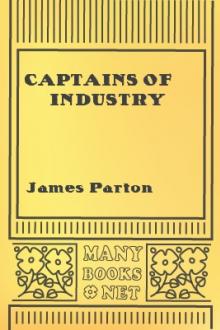Speeches, James Clear, Wolves Forever [best ereader manga TXT] 📗

- Author: James Clear, Wolves Forever
Book online «Speeches, James Clear, Wolves Forever [best ereader manga TXT] 📗». Author James Clear, Wolves Forever
You know, when Video Arts asked me if I'd like to talk about creativity I said “no problem!” No problem! Because telling people how to be creative is easy, it's only being it that's difficult.
I knew it would be particularly easy for me because I've spent the last 25 years watching how various creative people produce their stuff, and being fascinating to see if I could figure out what makes folk, including me, more creative.
What is more, a couple of years ago I got very excited because a friend of mine who runs the psychology department at Sussex University, Brian Bates, showed me some research on creativity done at Berkley in the 70s by a brilliant psychologist called Donald MacKinnon which seemed to confirm in the most impressively scientific way all the vague observations and intuitions that I'd had over the years.
The prospect of settling down for quite serious study of creativity for the purpose of tonight's gossip was delightful. Having spent several weeks on it, I can state categorically that what I have to tell you tonight about how you can all become more creative is a complete waste of time.
So I think it would be much better if I just told jokes instead.
You know the lightbulb jokes? How many Poles does it take to screw in a lightbulb? One to hold the bulb, four to turn the table. How many folksingers does it take to change a lightbulb? Answer: five, one to change the bulb and four to sing about how much better the old one was. How many socialists does it take to change a lightbulb? Answer: We're not going to change it, we think it works. How many creative art–
The reason why it is futile for me to talk about creativity is that it simply cannot be explained, it's like Mozart's music or Van Gogh's painting or Saddam Hussein's propaganda. It is literally inexplicable.
Freud, who analyzed practically everything else, repeatedly denied that psychoanalysis could shed any light whatsoever on the mysteries of creativity.
And Brian Bates wrote to me recently “Most of the best research on creativity was done in the 60s and 70s with a quite dramatic drop-off in quantity after then,” largely, I suspect because researchers began to feel that they had reached the limits of what science could discover about it.
In fact, the only thing from the research that I could tell you about how to be creative is the sort of childhood that you should have had, which is of limited help to you at this point in your lives.
However there is one negative thing that I can say, and it's “negative” because it is easier to say what creativity isn't.
A bit like the sculptor who when asked how he had sculpted a very fine elephant, explained that he'd taken a big block of marble and then knocked away all the bits that didn't look like an elephant.
Now here's the negative thing: Creativity is not a talent. It is not a talent, it is a way of operating.
So how many actors does it take to screw in a lightbulb? Answer: thousands. Only one to do it but thousands to say “I could have done that.” How many Jewish mothers does it take to screw in a lightbulb? Answer: Don't mind me, I'll just sit here in the dark, nobody cares about… How many surgeons —
You see when I say “a way of operating” what I mean is this: creativity is not an ability that you either have or do not have.
It is, for example, (and this may surprise you) absolutely unrelated to IQ (provided that you are intelligent above a certain minimal level that is) but MacKinnon showed in investigating scientists, architects, engineers, and writers that those regarded by their peers as “most creative” were in no way whatsoever different in IQ from their less creative colleagues.
So in what way were they different?
MacKinnon showed that the most creative had simply acquired a facility for getting themselves into a particular mood — “a way of operating” — which allowed their natural creativity to function.
In fact, MacKinnon described this particular facility as an ability to play.
Indeed he described the most creative (when in this mood) as being childlike. For they were able to play with ideas… to explore them… not for any immediate practical purpose but just for enjoyment. Play for its own sake.
Now, about this mood.
I'm working at the moment with Dr. Robin Skynner on a successor to our psychiatry book Families and How To Survive Them we're comparing the ways in which psychologically healthy families function (the ways in which such families function) with the ways in which the most successful corporations and organizations function.
We've become fascinated by the fact that we can usually describe the way in which people function at work in terms of two modes: open and closed.
So what I can just add now is that creativity is not possible in the closed mode.
Ok, so how many American network TV executives does it take to screw in a lightbulb? Answer: Does it have to be a lightbulb? How many doorke–
Let me explain a little. By the “closed mode” I mean the mode that we are in most of the time when at work.
We have inside us a feeling that there's lots to be done and we have to get on with it if we're going to get through it all.
It's an active (probably slightly anxious) mode, although the anxiety can be exciting and pleasurable.
It's a mode which we're probably a little impatient, if only with ourselves.
It has a little tension in it, not much humor.
It's a mode in which we're very purposeful, and it's a mode in which we can get very stressed and even a bit manic, but not creative.
By contrast, the open mode, is relaxed… expansive… less purposeful mode… in which we're probably more contemplative, more inclined to humor (which always accompanies a wider perspective) and, consequently, more playful.
It's a mood in which curiosity for its own sake can operate because we're not under pressure to get a specific thing done quickly. We can play, and that is what allows our natural creativity to surface.
Let me give you an example of what I mean.
When Alexander Fleming had the thought that led to the discovery of penicillin, he must have been in the open mode.
The previous day, he'd arranged a number of dishes to that culture would grow upon them.
On the day in question, he glanced at the dishes, and he discovered that on one of them no culture had appeared.
Now, if he'd been in the closed mode he would have been so focused upon his need for “dishes with cultures grown upon them” that when he saw that one dish was of no use to him for that purpose he would quite simply have thrown it away.
Thank goodness, he was in the open mode so he became curious about why the culture had not grown on this particular dish. And that curiosity, as the world knows, led him to the lightbulb — I'm sorry, to penicillin.
Now in the closed mode an uncultured dish is an irrelevance. In the open mode, it's a clue.
Now, one more example: one of Alfred Hitchcock's regular co-writers has described working with him on screenplays.
He says, “When we came up against a block and our discussions became very heated and intense, Hitchcock would suddenly stop and tell a story that had nothing to do with the work at hand. At first, I was almost outraged, and then I discovered that he did this intentionally. He mistrusted working under pressure. He would say “We're pressing, we're pressing, we're working too hard. Relax, it will come.” And, says the writer, of course it finally always did.
But let me make one thing quite clear: we need to be in the open mode when we're pondering a problem but once we come up with a solution, we must then switch to the closed mode to implement it. Because once we've made a decision, we are efficient only if we go through with it decisively, undistracted by doubts about its correctness.
For example, if you decide to leap a ravine, the moment just before take-off is a bad time to start reviewing alternative strategies. When you're attacking a machine-gun post you should not make a particular effort to see the funny side of what you are doing.
Humor is a natural concomitant in the open mode, but it's a luxury in the closed.
No, once we've taken a decision we should narrow our focus while we're implementing it, and then after it's been carried out we should once again switch back to the open mode to review the feedback rising from our action, in order to decide whether the course that we have taken is successful, or whether we should continue with the next stage of our plan. Whether we should create an alternative plan to correct any error we perceive.
And then back into the closed mode to implement that next stage, and so on.
In other words, to be at our most efficient we need to be able to switch backwards and forwards between the two modes.
But here's the problem: we too often get stuck in the closed mode.
Under the pressures which are all too familiar to us we tend to maintain tunnel vision at times when we really need to step back and contemplate the wider view.
This is particularly true, for example, of politicians. The main complaint about them from their non-political colleagues is that they become so addicted to the adrenaline that they get from reacting to events on an hour-by-hour basis that they almost completely lose the desire or the ability to ponder problems in the open mode.
And that's it. Well… 20 minutes to go… So, how many women's libbers does it take to change a lightbulb? Answer: 37, one to screw it in, and 36 to make a documentary about it. How many psychiatrists does it take to change a lightbulb? The answer: only one, but the lightbulb has really got to want to change.
Oh, there is one, just one, other thing that I can say about creativity.
There are certain conditions which do make it more likely that you'll get into the open mode, and that something creative will occur.
More likely… you can't guarantee anything will occur. You might sit around for hours as I did last Tuesday, and nothing.
Zilch.
Bupkis.
Not a sausage.
Nevertheless I can at least tell you how to get yourselves into the open mode. You need five things:
Space Time Time Confidence a 22 inch waistSorry, my mind was wondering. I'm getting into the open mode too quickly. Instead of a 22 inch waist, you need humor. I do beg your pardon.
Let's take space first: you can't become playful and therefore creative if you're under your usual pressures, because to cope with them you've got to be in the closed mode.
So you have to create some space for yourself away from those demands. And that means sealing yourself off.
You must make a quiet space for yourself where you will be undisturbed.
Next: Time. It's not enough to create space, you have to create your space for a specific period of time. You have to know that your space will last until exactly 3:30, and that at





Comments (0)